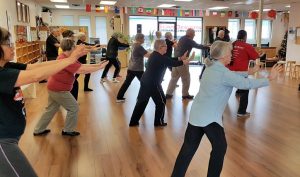Tai Chi Practice is a Cost-Effective Treatment to Reduce Falls in Older Adults
By John M. de Castro, Ph.D.
“Across multiple studies, Tai chi appears to reduce risk of falling by 20 to 45 percent and is considered one of the best exercises available for ambulatory older adults with balance concerns.” – Peter Wayne
The process of aging affects every aspect of the physical and cognitive domains. Every system in the body deteriorates including motor function with a decline in strength, flexibility, and balance. Impaired balance is a particular problem as it can lead to falls. In the U.S. one third of people over 65 fall each year and 2.5 million are treated in emergency rooms for injuries produced by falls. About 1% of falls result in deaths making it the leading cause of death due to injury among the elderly.
Falls, with or without injury, also carry a heavy quality of life impact. A growing number of older adults, fear falling and, as a result, limit their activities and social engagements. This can result in further physical decline, depression, social isolation, and feelings of helplessness. It is obviously important to discover methods to improve balance and decrease the number of falls in the elderly.
Tai Chi training is designed to enhance and regulate the functional activities of the body through regulated breathing, mindful concentration, and gentle movements. It includes balance training and has been shown to improve balance and coordination. Indeed, Tai Chi training has been shown to reduce the frequency of falls in the elderly. It is not known, however, if Tai Chi training is more or less cost-effective than other exercises for reducing falls in the elderly.
In today’s Research News article “Cost-Effectiveness of a Therapeutic Tai Ji Quan Fall Prevention Intervention for Older Adults at High Risk of Falling.” (See summary below or view the full text of the study at: https://www.ncbi.nlm.nih.gov/pmc/articles/PMC6696718/), Li and colleagues recruited community-based elderly individuals (over 70 years of age) who had experienced at least one fall in the last year and randomly assigned them to one of three conditions; Tai Chi practice, multimodal (mixed) exercises, or stretching. The exercises occurred in twice weekly, 60-minute sessions, for 24 weeks. They were measured before and after training for falls, health related quality of life, health index, quality-adjusted life-years (QALYs), and health-related service utilization expenses.
They found that Tai Chi practice resulted in significantly greater reduction in falls and increase in quality-adjusted life-years (QALYs) than either the multimodal or stretching exercises. The costs of implementing the 3 programs were equivalent. The total health-related utilization cost was $1,958 per participant for Tai Chi, compared with $2,583 for multimodal and $2,131 for stretching. Tai Chi produced greater reductions in falls at a lower cost and resulted in lower health care costs results in in incremental costs of $850 per additional fall prevented and $27,614 per additional QALY gained.
These results suggest that Tai Chi practice is a safe, effective, and cost-effective means of reducing falls in the elderly. Falls when they occur in the elderly can be quite devastating and can produce major injuries that can even lead to death. So, their prevention is very important not just for reducing health care costs but for the longevity and quality of life of the individual.
So, Tai Chi practice is a cost-effective treatment to reduce falls in older adults.
“Falling in adults age 65 and older is significantly associated with loss of independence, premature mortality and big health care costs.” – Peter Harmer
CMCS – Center for Mindfulness and Contemplative Studies
This and other Contemplative Studies posts are also available on Google+ https://plus.google.com/106784388191201299496/posts and on Twitter @MindfulResearch
Study Summary
Li, F., Harmer, P., Eckstrom, E., Fitzgerald, K., Akers, L., Chou, L. S., … Winters-Stone, K. (2019). Cost-Effectiveness of a Therapeutic Tai Ji Quan Fall Prevention Intervention for Older Adults at High Risk of Falling. The journals of gerontology. Series A, Biological sciences and medical sciences, 74(9), 1504–1510. doi:10.1093/gerona/glz008
Abstract
Background
Data on the cost-effectiveness of proven fall prevention exercise interventions are limited. We aimed to establish the cost-effectiveness of Tai Ji Quan: Moving for Better Balance (TJQMBB) compared with a conventional exercise intervention for older adults at high risk of falling.
Methods
We conducted a trial-based cost-effectiveness analysis involving 670 older adults who had a history of falling or impaired mobility. Participants received one of three interventions—TJQMBB, multimodal exercise, or stretching exercise (control)—each of which was implemented twice weekly for 24 weeks. The primary cost-effectiveness measure was the incremental cost per additional fall prevented, comparing TJQMBB and multimodal exercise to Stretching and TJQMBB to multimodal exercise, with a secondary measure of incremental cost per additional quality-adjusted life-year (QALY) gained. The intervention was conducted between February 2015 and January 2018, and cost-effectiveness was estimated from a health care system perspective over a 6-month time horizon.
Results
The total cost to deliver the TJQMBB intervention was $202,949 (an average of $906 per participant); for multimodal exercise, it was $223,849 ($1,004 per participant); and for Stretching, it was $210,468 ($903 per participant). Incremental cost-effectiveness ratios showed that the multimodal exercise was cost-effective ($850 per additional fall prevented; $27,614 per additional QALY gained) relative to Stretching; however, TJQMBB was the most economically dominant strategy (ie, having lower cost and being clinically more efficacious) compared with multimodal and stretching exercises with regard to cost per additional fall prevented and per additional QALY gained. TJQMBB had a 100% probability of being cost-effective, relative to Stretching, at a threshold of $500 per each additional fall prevented and $10,000 per additional QALY gained. Sensitivity analyses showed the robustness of the results when extreme cases, medical costs only, and missing data were considered.
Conclusions
Among community-dwelling older adults at high risk for falls, TJQMBB is a cost-effective means of reducing falls compared with conventional exercise approaches.
https://www.ncbi.nlm.nih.gov/pmc/articles/PMC6696718/
